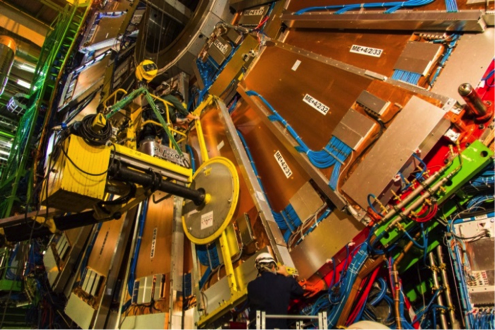
Since March this year new layers of Muon chambers have been added to CMS on both YE3 endcap disks. Two additional rings of 36+36 Cathode Strip Chambers (CSC), which complete the forward η coverage of muon station 4 (so-called ME4/2) in the region 1.2|η|1.8, have been installed, commissioned and have already participated to the April Global Run. The new chambers will improve muon reconstruction and trigger performances in the forthcoming LHC Runs.
The 72 CSCs, plus 5 additional spares, have been assembled and tested at CERN, at the Muon Detector Facility located in B904 on the Prevessin site. Chamber panels were manufactured at Fermilab while other chamber parts were procured in US. Detector construction at CERN started in May 2011 and was completed in December 2013 at an assembly rate of ~4 CSCs per month. A truly international team consisting of more than 50 technicians, students and physicists from the US, Europe, Russia and China has been working on the project throughout its duration.
The CSCs were installed in CMS in two periods: November 2013 on YE+3 and March 2014 on YE-3. Chambers are attached to the disks according to a staggered geometry, with front and back chambers of the same ring alternating and overlapping in φ. The sequence consists in installing the back-layer chambers first, cable the on-chamber electronics and run a series of functionality tests, then install the front-layer chambers, which partially cover the back layer, and complete the cabling. Finally, the full integration of detector services (chamber gas and cooling) is done before powering the whole system and beginning the full commissioning. The latter consists in submitting the detector system to a set of functionality tests using standard DAQ and triggering on cosmic rays.
The CSCs are quite heavy and sizeable objects that require technical skill and specialized tooling for their installation. The experience gained with the 468 CSCs already installed in CMS makes this appear as a rather straightforward operation, despite several crucial and challenging steps one has to take into account. Such a delicate operation has been generally reserved to a team of experts who have been around since the early days of CMS. This time, new and young members of the Collaboration have been participating in the chamber installation effort and are now being trained to inherit the know-how and all the skills needed in order to maintain the CSC system at its highest operational standard.
By Armando Lanaro
- Log in to post comments

